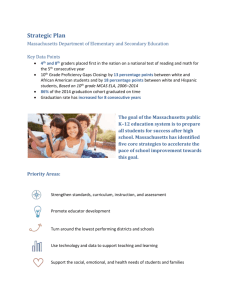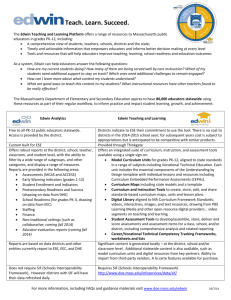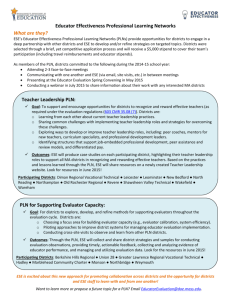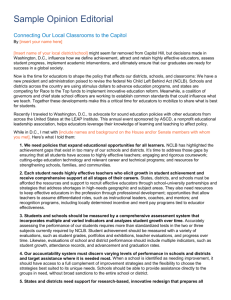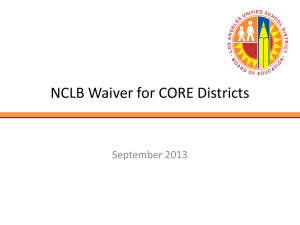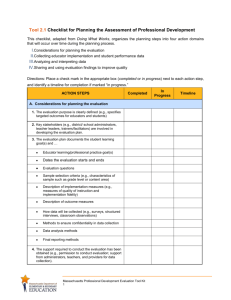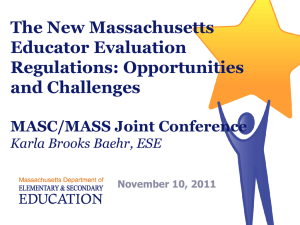Quick Reference Guide on ESE Reforms for District and School
advertisement
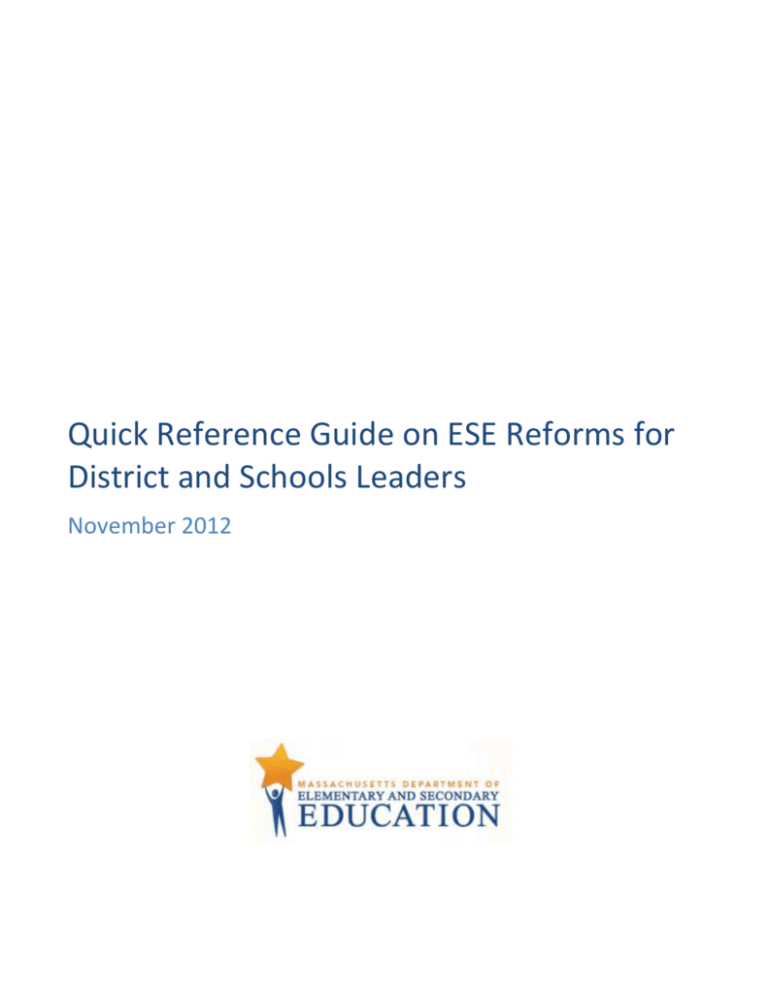
Quick Reference Guide on ESE Reforms for District and Schools Leaders November 2012 Contents ACHIEVEMENTS ....................................................................................................................................................... 2 CONTINUING CHALLENGES ..................................................................................................................................... 2 OUR MISSION .......................................................................................................................................................... 2 PRIMARY STRATEGIES.............................................................................................................................................. 2 OVERARCHING MISSION: SUCCESS AFTER HIGH SCHOOL................................................................................... 3 STRATEGY 1: Strengthen Curriculum, Instruction, and Assessment ................................................................... 4 STRATEGY 2: Improve Educator Effectiveness .................................................................................................... 5 STRATEGY 3: Turn Around Low Performing Districts and Schools ...................................................................... 6 STRATEGY 4: Use Data and Technology to Support Student Performance ......................................................... 7 KEY LEVER: No Child Left Behind (NCLB) Flexibility ............................................................................................. 8 1|Page Quick Reference Guide on ESE Reforms for District Leaders ACHIEVEMENTS Massachusetts 4th and 8th graders have scored first or tied for first in the nation in reading and mathematics for four consecutive NAEP administrations (2005, 2007, 2009 and 2011). 83.4% of MA students in the 2011 cohort graduated within four years – the highest rate ever and fifth year in a row the rate has increased. The state's annual dropout rate in 2011 was 2.7 percent, the lowest rate in two decades and third year in a row it fell below 3 percent. More than 15,000 Massachusetts students in the class of 2011 scored a 3 or higher on at least one Advanced Placement exam during high school, nearly double the number from a decade ago. Massachusetts was the top scoring state in the federal Race to the Top competition. CONTINUING CHALLENGES Proficiency gaps are large and persistent – and disproportionately affect students who are from low income families, students with disabilities, or English language learners. One-quarter of MA high school graduates do not enroll in college within 16 months of completing high school. 37% of Massachusetts public high school graduates who enroll at public universities in Massachusetts need remediation during their first semester in college. At community colleges, that number rises to 65%. OUR MISSION Our mission is to strengthen the Commonwealth's public education system so that every student is prepared to succeed in postsecondary education, compete in the global economy, and understand the rights and responsibilities of American citizens, and in so doing, to close all proficiency gaps. PRIMARY STRATEGIES We are committed to preparing all students to succeed in the world that awaits them after high school by: Strengthening curriculum, instruction, and assessment Improving educator effectiveness Turning around the lowest performing districts and schools Using data and technology to support student performance ESE's Core Mission and Primary Strategies Prepare all students for success after high school Strengthen curriculum, instruction, and assessment 2|Page Improve educator effectiveness Turn around low performing districts and schools Use data and technology to support performance OVERARCHING MISSION: SUCCESS AFTER HIGH SCHOOL We will ensure that Massachusetts students are prepared for success and opportunities after high school – including career and higher education opportunities. Being college and career ready means that a student has the knowledge, skills, and experiences necessary for success in postsecondary education and economically viable career pathways in a 21st century economy. All efforts across the K-12 pipeline are ultimately aimed at increasing the number of students who graduate from high school ready for postsecondary success. The state's Task Force on Integrating College and Career Readiness recommended creating a statewide system of structured, aligned, and strategic partnerships to support each student’s transition from the K–12 system through post-secondary education and into successful careers. Action steps include: Incorporating career readiness into the state’s recommended course of study (MassCore); Strengthening school, employer, higher education, and community partnerships; Improving the utilization of school counselors in the deployment of career readiness education; Incentivizing schools to create and demonstrate comprehensive career readiness strategies; Promoting the importance of college and career readiness for all students; Explicitly identifying ESE personnel responsible for effectively executing the recommendations. Additional resources ESE's College and Career Readiness page Task Force Report on Integrating College and Career Readiness Academic Support program Connecting Activities program MassGrad program Information on MassCore Mass Model for School Counseling 3|Page Strategies to achieve this mission Build on existing programming to expand career development models Identify and extract career ready "power standards" Identify a wide range of local formative and summative assessments that have potential to measure career readiness standards Establish an "Employer Champions" group Develop a toolkit and resources for all partners to access information Provide Academic Support programming for students who have not earned or who may be at risk for not earning their Competency Determination (CD) Support implementation of MassCore, our recommended high school course of study, that will help ensure students are prepared for success after high school Implement the MassGrad initiative, which provides dropout prevention programming and a professional development network charged with sharing dropout prevention and recovery strategies Implement the Mass Model for School Counseling to empower guidance staff to lead systemic school change and support a holistic approach to supporting student achievement Increase number of counselors using YourPlanForTheFuture.org Expand Connecting Activities capacity to prepare and place students in a variety of career development activities Develop and launch competitive funding opportunities Make statewide tools and resources available online to promote readiness for college and careers Sponsor statewide summits for educators, employers, workforce development partners, and others STRATEGY 1: Strengthen Curriculum, Instruction, and Assessment What will implementation of new frameworks mean? The implementation of the 2011 MA Curriculum Frameworks in ELA and Math, which incorporate the Common Core State Standards, will require significant instructional shifts and a focus on deeper learning. Some specific changes you can anticipate include: We will implement a world-class curriculum that engages students in their learning at all levels. This will include: Full implementation of the 2011 MA Curriculum Frameworks in English language arts and mathematics, ELA: which incorporate the Common Core State Standards; Use of both literacy nonfiction and Full implementation of the World-Class Instructional informational texts Design and Assessment (WIDA) standards for English Shared responsibility for literacy in language learners; history, science, the arts, and Implementing Rethinking Equity and Teaching for English technical subjects Language Learners (RETELL), an initiative to improve and Reading and writing grounded in support the academic achievement of English language text learners. This systemic approach involves professional Focus on language development development on Sheltered English Immersion (SEI) to through speaking, listening, and enable teachers to make rigorous content accessible to vocabulary their students. We will adopt the Partnership for Assessment of Readiness for Math: College and Careers (PARCC) English language arts and Greater focus, clarity, and rigor mathematics assessments, provided they are as good as, or better Increased coherence and than, our current MCAS assessments. PARCC is a 23-state connections across content and consortium working to develop next generation K-12 assessments grades in ELA and math. PARCC has the potential to strengthen teaching Focus on college and career and learning and close proficiency gaps. If we adopt PARCC, we readiness standards for will administer these assessments beginning in 2014-15. mathematical practice in all grades Beginning in 2012-13, English language learner students (ELLs) in grades K-12 will take the ACCESS for ELLs tests. ACCESS for ELLs, which replaces MEPA, is the state's new test to measure ELL students' listening, speaking, reading, and writing skills. We have developed the Massachusetts Tiered System of Support (MTSS) to guide the provision of high-quality core educational experiences in a safe and supportive learning environment for all students as well as academic and/or non-academic targeted supports both for students who experience difficulties and for those who have already demonstrated mastery. Available Resources ESE's Curriculum & Instruction page Resources for Implementing the MA Curriculum Frameworks in 2012-13 ACCESS Assessment for ELLs Rethinking Equity and Teaching for English Language Learners (RETELL) PARCC Model Content Frameworks Massachusetts Tiered System of Support 4|Page STRATEGY 2: Improve Educator Effectiveness We will improve instruction by supporting educators through every stage in their career. These stages are: recruitment, preparation, assessment and licensure, selection and hiring, evaluation, professional development, and retention. Strategies include: Supporting continuous improvement of teachers and administrators and rewarding excellence Providing useful and timely feedback through evaluations and opportunities for growth Creating aligned, rigorous, high quality standards for teacher preparation programs, licensure requirements, professional development courses, and the educator evaluation system Building strong partnerships between districts and educator preparation programs Improving professional development opportunities The intent of these efforts is to improve the quality of professional development experiences, ensure preparation programs are preparing teachers and leaders with the tools they need to be effective, and help identify areas of strength and weakness, which will guide teachers in their efforts to improve their practice. Available Resources ESE's Educator Evaluation page Evaluation Training Programs Training Modules to Support Implementation Regulations on Evaluation of Educators Regulations for Educator Licensure and Preparation Program Approval ESE’s Educator Services page 5|Page What is the new Massachusetts Educator Evaluation System? On June 28, 2011, the Board of Elementary and Secondary Education adopted new regulations for the evaluation of the state’s educators. The regulations are designed to: Promote growth and development of leaders and teachers Place student learning at the center, using multiple measures of student learning, growth and achievement Recognize excellence in teaching and leading Set a high bar for professional teaching status Shorten timelines for improvement Evaluations include: A 5-step evaluation cycle (selfassessment, analysis, goal setting and plan development; implementation; formative assessment/evaluation; summative evaluation Four Standards of performance Administrators Instructional Leadership Management & Operations Family & Community Partnerships Professional Culture Teachers Curriculum, Planning & Assessment Teaching All Students Family & Community Engagement Professional Culture Four levels of performance: Exemplary, Proficient, Needs Improvement, Unsatisfactory Three levels of impact on student learning: Low, Moderate, High Different paths and plans for growth and improvement depending on career stage and performance STRATEGY 3: Turn Around Low Performing Districts and Schools We will rapidly improve our lowest performing schools and districts through targeted district intervention that addresses the core issues causing poor student performance. Targeting districts allows all students in a district to have access to high-quality learning opportunities. We support this work in many ways, including: using federal resources strategically identifying expert partners to support turnaround efforts addressing students’ non-academic needs through the Wraparound Zones and Massachusetts Tiered System of Support ESE differentiates support and accountability so that the higher a district’s or school’s accountability level (1 to 5), the greater assistance that district or school receives. Low performing schools can be turned around through professional development and targeted assistance that will give students access to high-quality learning opportunities that prepare them for life after high school. Early successes across the state suggest that the following practices have contributed to dramatic turnaround: Having a principal whose main focus is on quality instruction and results. Teaming and coaching centered around quality instruction Employing a school-wide tiered system of instruction Key Efforts and Opportunities Underway to Support School Turnaround School Redesign Grants ESE offers support to districts in developing Turnaround Plans Priority Partners have been identified by the state to support districts in improving the conditions for school effectiveness Wraparound Zone Initiative Tiered systems of support (MTSS) are implemented in all districts, ensuring responsiveness to English language learners (ELLs) and students with disabilities Grant opportunities are available through the Educator Evaluation and Teacher Incentive Fund (TIF) Available resources Emerging Practices in Rapid Achievement Gain Schools, February 2012 Conditions for School Effectiveness District and School Assistance Center (DSAC) information District Standards and Indicators District Self-Assessment Tool ESE Priority Partners Wraparound Zones Framework for District Accountability and Assistance District Analysis, Review, and Assistance Tools (including DART) Massachusetts Tiered System of Support Regulations for Accountability and Assistance in School Districts and Schools, 603 CMR 2.00 6|Page STRATEGY 4: Use Data and Technology to Support Student Performance ESE is developing new ways for educators to access valuable data so they may improve practice and support student achievement The Department is committed to providing the pieces of data and information that will be the most effective in improving student achievement. ESE promotes a culture of effective data-informed decisionmaking at all levels of the education spectrum, from teachers in the classroom to policymakers at the state level Professional learning communities are essential vehicles for effective, sustained use of data to improve teaching and learning Technology is a force in all our lives, and can inform and strengthen teaching and learning in our schools. Our students are surrounded by technology at home; the same should and can be true in school. There are many ways that technology can be integrated into our classrooms, and we should consider them as options as we seek to improve instruction. We have developed an Early Warning Indicator System (EWIS) for grades 1-12 to help educators more systemically identify students that are at risk for not meeting expected academic goals, such as passing all grade 9 courses and graduating from high school. These efforts will be greatly enhanced by the launch of Edwin, the state’s new teaching and learning system, which will provide educators with curriculum resources as well as numerous student-level data reports. Edwin will be a cost-effective alternative to other instructional management systems available and being used across the state, and a place where we can centralize high quality instructional resources in one convenient location. Available Resources Edwin ESE Education Data/Information Services Information on the Early Warning Indicator System Explore student data using Professional Learning Communities 7|Page What is Edwin? Designed to be an integrated suite of tools to help educators at every level, Edwin is the state’s new teaching and learning platform. Edwin is comprised of two parts: Edwin Teaching and Learning, and Edwin Analytics Edwin Teaching and Learning will include curriculum tools (model curriculum units, curriculum mapping tools, and lesson planning tools all aligned to the latest curriculum standards); high quality digital resources; and assessment tools to gauge student understanding of standards. Districts that choose to adopt some or all of these system components should see cost savings in their expenditures for software and other systems. Edwin Analytics will provide access for all educators to all kinds of dashboards and reports on student information (profiles, attendance data, assessment results, early warning indicators, etc.) KEY LEVER: No Child Left Behind (NCLB) Flexibility In 2012, Massachusetts received a waiver for certain elements of the federal No Child Left Behind law. Through the waiver, we have unified state and federal requirements, allowing us to tailor our accountability and assistance system to meet the actual needs of our districts. The state sought flexibility from NCLB to: Unify accountability & assistance systems Bring together state & federal requirements Better differentiate between schools Incentivize improved student achievement in all schools Identify schools that need the most assistance overall & for certain student subgroups Recognize high achieving and improving schools Focus more deliberately on proficiency gaps Incorporate growth in accountability determinations Districts have access to new resources, including: Redesigned online district analysis, review, and assistance tools, as well as new accountability reports Priority assistance and consultation for level 3 districts from the regional District and School Assistance Centers (DSACs) Direct support for level 4 districts from an appointed ESE liaison Available Resources ESEA Waiver: Changes to the School and District Accountability System MA ESEA Waiver Request (January 18, 2012) 8|Page What has changed through NCLB flexibility? The NCLB goal of 100 percent proficiency is replaced with a new goal of reducing proficiency gaps by half by 2017. The NCLB accountability status labels of improvement, corrective action, and restructuring are eliminated. Only state accountability and assistance levels (1-5) are used for districts and schools. AYP is replaced with the Progress & Performance Index (PPI), which combines information about narrowing proficiency gaps, growth, and graduation and dropout rates into a single number. All districts, schools, and groups with sufficient data are assigned an annual PPI based on two years of data. The annual PPI measures progress toward narrowing proficiency gaps from one year to the next. The cumulative PPI measures progress over four years toward narrowing proficiency gaps. For a group to be considered to be making progress toward narrowing proficiency gaps, its cumulative PPI must be 75 or higher. A school percentile between 1 and 99 is reported for schools with at least four years of data. Reports show a new "high needs" subgroup, an unduplicated count of all students in a school or district belonging to at least one of the following individual subgroups: students with disabilities, English language learners (ELL) or former ELL, or low income students.
